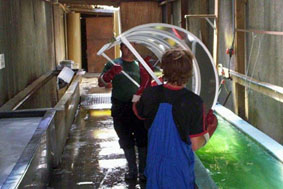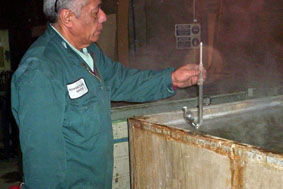Home > Pre-treatment
Pre-treatment and Preparation
At Powder Coating Services, every job undergoes thorough preparation before we apply the powder coat.
Pre-treatment
Pre-treatment is the process of chemical preparation of various types of metal and aluminium prior to the application of a powder coated surface finish. In all cases of powder coating, appropriate surface pre-treatment is vital for ensuring long lasting results. Pre-treatment is key to quality – as important to the performance of the finished powder coated product as the materials used in its construction, its design, and the conditions under which it is employed. At Powder Coating Services, it is absolutely essential that high standards of pre-treatment are maintained, to ensure a consistently high-quality end product.



When an article for powder coating is immersed in our pre-treatment tanks, a chemical reaction takes place to convert the surface layer into an integral and flexible non-metallic barrier. This chemically converted layer adheres strongly to the item’s surface to provide an effective key for the finished powder coated product. The layer is designed to inhibit the start and spread of corrosion, whether exposure to the risk occurs before or after the powder coat is applied.
Powder Coating Services has extensive on-site pre-treatment facilities suitable to process a range of metals in sheet, tubular and fully manufactured form. Large frames and product forms are accommodated using a recommended spray poly-etching process suitable for metal products, including galvanised steel, ferrous and non-ferrous metals.
Over our many years of experience in the business, we have collected large amounts of data on powder coated product performance from the field, with documented in-house and laboratory testing. We are in close and constant communication with our pre-treatment material suppliers, staying up to date with industry trends to deliver the latest, most appropriate powder coating preparation methods and processes.
Powder Coating Services has extensive on-site pre-treatment facilities suitable to process a range of metals in sheet, tubular and fully manufactured form. Large frames and product forms are accommodated using a recommended spray poly-etching process suitable for metal products, including galvanised steel, ferrous and non-ferrous metals.
Over our many years of experience in the business, we have collected large amounts of data on powder coated product performance from the field, with documented in-house and laboratory testing. We are in close and constant communication with our pre-treatment material suppliers, staying up to date with industry trends to deliver the latest, most appropriate powder coating preparation methods and processes.
Wet Stripping

Old or conflicting pre-coated materials may be removed from an object, by wet stripping - a chemical process applied through immersion in a liquid. The alternative is sandblasting (refer below).
Powder Coating Services has both in-house facilities and partner agreements with sub-contractors to efficiently wet strip hard-to-remove powder coatings from intricate parts and shapes. Items brought in for powder coating are first sorted according to the pre-treatment processes required, and older products are often in such poor condition that sandblasting may not be suitable. The alternative is immersion tank dipping, conducted at room temperature, which applies acid surface processes to remove and neutralize corrosion as required. Waste solids and expired chemicals are removed and treated by approved sub-contractors to comply with all local authority by-laws and sound environmental protection practices.
The chemicals and processes we use in pre-treatment are compatible with most known metals*. They safely remove powder coatings from galvanized steel, aluminium, zinc, copper, brass, mild steel and stainless steel.
* Magnesium may react to paint removal strippers and items containing that element should not be powder coated. Examples are some very expensive lightweight motorsport wheels and racing bicycles. It is recommended that these not be put through the powder coating process, but rather garnet blasted as necessary and automotive wet sprayed.
Sand Blasting

Sand blasting is the act of propelling very fine pieces of material at high-velocity to clean or etch a surface. It is an effective way of removing oxide and rust from black or welded mild steel, and provides an excellent surface for subsequent chemical pre-treatment or as a key for powder coating.
There are four main types of blasting media used.
- Garnet is free from silica and iron particles, and would generally be used for mobile or onsite applications as it has lower dust levels than iron sand. It is sourced from India and Australia.
- Grit consists of finely crushed ball bearings, and gives steel the blast profile needed for paint to adhere to the surface. Grit cannot be used on any material that uses a magnetic force, such as alternators.
- Shot is a ball bearing-like blasting medium, comprising small particles of 0.04mm to 1.4mm. It is popular with recycling units as it can be reused 40 to 50 times. As with grit, shot cannot be used with anything that has a magnetic force.
- Iron sand is a traditional blasting medium, sourced from beaches around New Zealand. Recent studies have shown iron sand to be hazardous to operators of blasting equipment, resulting in declining use. Iron sand is relatively fine and is most commonly used when blasting car panels and glass.
To ensure your items get the sandblasting treatment they need, we work closely with local specialists.


